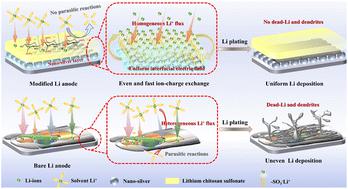当前位置:
X-MOL 学术
›
J. Mater. Chem. A
›
论文详情
Our official English website, www.x-mol.net, welcomes your
feedback! (Note: you will need to create a separate account there.)
Synergistic dual-interface engineering with self-organizing Li-ion/electric fields for enhanced lithium metal anode stability
Journal of Materials Chemistry A ( IF 10.7 ) Pub Date : 2024-09-11 , DOI: 10.1039/d4ta03128h Zhiqiang Li 1 , Kemeng Liao 2 , Lihong Yin 2 , Zongrun Li 2 , Yingzhi Li 2 , Hongzhi Wang 2 , Ning Qin 2 , Shuai Gu 2 , Jingjing Chen 2 , Weihua Wan 3 , Zhouguang Lu 2
Journal of Materials Chemistry A ( IF 10.7 ) Pub Date : 2024-09-11 , DOI: 10.1039/d4ta03128h Zhiqiang Li 1 , Kemeng Liao 2 , Lihong Yin 2 , Zongrun Li 2 , Yingzhi Li 2 , Hongzhi Wang 2 , Ning Qin 2 , Shuai Gu 2 , Jingjing Chen 2 , Weihua Wan 3 , Zhouguang Lu 2
Affiliation

|
Lithium metal is promising anode material for next-generation ultra-high energy batteries due to its unparalleled theoretical capacity. Nonetheless, its practical application is largely hindered by interfacial instability. Herein, we propose an interfacial engineering strategy employing a sandwich-structured interface comprising a nano-silver (Ag) inner layer and a lithium chitosan sulfonate (LCS) outer layer. The lithophilic nano-silver layer, with its uniformly distributed three-dimensional structure, ensures a consistent interfacial electric field and robustly anchors the LCS, mitigating delamination or decoupling from the Li metal surface during Li plating/stripping. Simultaneously, the LCS coating, characterized by its polysaccharide glycosidic structure, not only delivers exceptional elasticity and mechanical strength but also serves as a robust artificial solid-electrolyte interphase (SEI) layer, preserving the interface's structural integrity. Additionally, the LCS's sulfonic acid groups (–SO3Li) further promote uniform Li-ion flux and maintain high Li+ ionic conductivity. These synergistic effects significantly improve the specific discharge capacity and cycling stability of a C–AgLi‖LiCoO2 full cell, achieving a capacity retention of 83.8% after 350 cycles. These findings elucidate a pathway towards the practical utilization of Li metal anodes by enhancing Li-ion flux, electric field uniformity, and interface adhesion, thus effectively inhibiting Li dendrites.
中文翻译:

具有自组织锂离子/电场的协同双界面工程可增强锂金属负极的稳定性
锂金属因其无与伦比的理论容量而成为下一代超高能电池的有前途的负极材料。然而,其实际应用在很大程度上受到界面不稳定性的阻碍。在此,我们提出了一种界面工程策略,采用包含纳米银(Ag)内层和壳聚糖磺酸锂(LCS)外层的三明治结构界面。亲石纳米银层具有均匀分布的三维结构,可确保一致的界面电场并牢固地锚定LCS,从而减轻镀锂/剥离过程中与锂金属表面的分层或去耦。同时,以多糖糖苷结构为特征的 LCS 涂层不仅具有卓越的弹性和机械强度,而且还可以作为坚固的人造固体电解质界面 (SEI) 层,保持界面的结构完整性。此外,LCS 的磺酸基团 (–SO 3 Li) 进一步促进均匀的锂离子通量并保持高的 Li +离子电导率。这些协同效应显着提高了C-AgLi‖LiCoO 2全电池的比放电容量和循环稳定性,在350次循环后容量保持率达到83.8%。这些发现阐明了通过增强锂离子通量、电场均匀性和界面粘附力,从而有效抑制锂枝晶,实现锂金属负极的实际应用的途径。
更新日期:2024-09-11
中文翻译:

具有自组织锂离子/电场的协同双界面工程可增强锂金属负极的稳定性
锂金属因其无与伦比的理论容量而成为下一代超高能电池的有前途的负极材料。然而,其实际应用在很大程度上受到界面不稳定性的阻碍。在此,我们提出了一种界面工程策略,采用包含纳米银(Ag)内层和壳聚糖磺酸锂(LCS)外层的三明治结构界面。亲石纳米银层具有均匀分布的三维结构,可确保一致的界面电场并牢固地锚定LCS,从而减轻镀锂/剥离过程中与锂金属表面的分层或去耦。同时,以多糖糖苷结构为特征的 LCS 涂层不仅具有卓越的弹性和机械强度,而且还可以作为坚固的人造固体电解质界面 (SEI) 层,保持界面的结构完整性。此外,LCS 的磺酸基团 (–SO 3 Li) 进一步促进均匀的锂离子通量并保持高的 Li +离子电导率。这些协同效应显着提高了C-AgLi‖LiCoO 2全电池的比放电容量和循环稳定性,在350次循环后容量保持率达到83.8%。这些发现阐明了通过增强锂离子通量、电场均匀性和界面粘附力,从而有效抑制锂枝晶,实现锂金属负极的实际应用的途径。

































 京公网安备 11010802027423号
京公网安备 11010802027423号